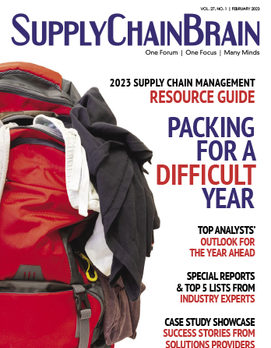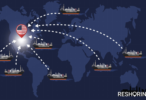
Home » For Shippers, Disruption Means Opportunity to Rethink Carrier Strategy
SCB FEATURE
For Shippers, Disruption Means Opportunity to Rethink Carrier Strategy

Photo: iStock.com/fizkes
March 21, 2023
The business of road freight is in upheaval. Ports on the U.S. West Coast could permanently lose as much as 10% of the seaborne cargo that has been diverted to the Atlantic Coast, according to Bloomberg news service. Added to other disruptive pressures on trade and freight patterns over the past three years, that translates into a massive shift in inland road freight arrangements.
Some industry executives say that this, in turn, presents an opportunity for shippers to re-vamp their strategies and relationships with road carriers — not least making more of smaller, regional carriers. They may also re-think business arrangements as fundamental as requests for proposals (RFPs).
There’s a chance to reconfigure shipper-carrier relationships in a profound way that may well have been a long time coming, says Heather Mueller, chief marketing and product officer at Breakthrough, a transportation management and technology provider in Green Bay, Wisconsin. “It’s an exciting time to be able to consider changes in the supply chain, and in transportation relationships overall,” Mueller says. “There’s more appetite for change because of what we’ve lived through in the last few years. We were talking about this before the pandemic, but then changes in shipping patterns and much more showed us clearly that we had some broken systems.” Mueller says the result is a new “openness” on the part of both shippers and carriers to try things differently.
Paul Brashier, vice president drayage and intermodal at ITS Logistics, sees changes afoot, but credits it more to capacity changes putting shippers once again in a position of power. “Shippers are in the driver's seat, and they have made it a point to change language in the contracts to minimize the exposure they have to demurrage and per diem as well as taking over their own trucking,” he says.
Brashier says the largest change is the removal of “door booking,” which is where the ocean carrier is responsible for executing the domestic dray. “Shippers are taking that back, to control their transportation,” he says.
Mueller thinks it’s time for the RFP process to change, in order to reflect the new needs of shippers. “Let’s start with the [idea of the] RFP in total. This is something that’s an industry standard forever, since deregulation,” she says. “Shippers say, this is the way we go about getting carriers into our network.” The common approach has been to use the RFP to secure a one- or two-year transportation arrangement, with an expected cadence of freight, bound to traditional peak seasons or other calendar events.
Mueller thinks there’s room for greater flexibility because the consumer market has changed so radically – for example, away from predictable, short, peak seasons. “There was an awareness that [the traditional RFP process] wasn’t working too well, but all our systems were built around this, including compliance and financial projections for the entire organization. Your purchasing department held you to it,” she says. “But now, it’s not necessarily responsive to needs.”
“There was no catalyst for this to change until 2020, when we saw that the best-laid plans for the transportation calendar could be destroyed by catastrophic events,” she says. “We also saw consumer behavior and preferences change, along with an appetite for sustainability and environmental considerations.” Fundamentally, there are changes afoot in the way shippers are getting goods to market, and to final consumers.
Brashier says it’s certainly true that RFP activity is generating contracts that now last a year or less. But, he says, with rates at the lowest they have been in years, some shippers are actually trying to extend terms for longer in order to lock in those rates. This back-and-forth, however, is nothing new. “Carriers will come off those [terms] if the market changes as it did the last 18-24 months,” he says.
All the same, it’s not just business as usual, Mueller argues. Or shouldn’t be. “We’re encouraging more of our clients to think before they just do an RFP in January with their whole carrier network because that’s the way they’ve always done it. We want them to ask: Is it necessary?” She says shippers should be analyzing their arrangements with transport and distribution partners on a case-by-case basis. Some, she says, are shifting their strategies.
“That is a trend that I’m really excited about, and I think shippers are feeling good about,” Mueller says. “RFPs are disruptive to both carriers and shippers. They’re incredibly time-consuming.”
Critical to making a shift away from the traditional RFP process into a business environment that’s more sensitive to supply-and-demand realities is access to timely and accurate data, Mueller says. “A shipper can’t move away from the traditional RFP if they don’t have data about the expected performance of partners they’re bringing to the table, and what the rates are likely to be.”
Mueller says it’s important to understand the longevity and reliability of benchmarking when it comes to predicting rates and capacity. “Maybe you should use more than one benchmark,” she suggests. “And quality data is absolutely essential to making sure you can be more proactive about managing rates, so you don’t end up with unpredicted costs.”
Armed with good data, shippers can make realistic determinations about what is an appropriate shipping cost. “You can set that as an anchor in negotiations,” Mueller suggests. “Instead of opening it up to 200 carriers and asking them, what would you like me to pay you on this lane, you can narrow your pool to carriers that fit, and say, I think the appropriate price is, for example, $2 per mile, and see how they respond to that. It totally changes the dynamic, and also the response time.”
This new approach makes it easier to unlock the latent value in regional carrier networks, Mueller says. “A lot of large national shippers don’t know the small regional players if they’re not near their headquarters, or if they haven’t seen them on the road, because those carriers don’t have a strong marketing presence,” Mueller says. “But they do have meaningful capacity that can have an impact on a large shipper. It’s just that the shipper doesn’t know how to find them.”
Mueller says that having access to a data set that allows shippers to look for carriers in specific lanes and regions is the first step to unlocking the process. “Historically, this has been managed by some sort of carrier contact binder full of business cards,” she says. “We can do so much better than that today.”
“Shippers need to understand what we call the transportation ecosystem data,” Mueller concludes. “There’s an enormous amount of wealth in regional carriers that do really well. Being able to unlock that capacity is a huge boon for shippers.” To do so, though, shippers need to form a good understanding of the operations of each carrier they’re working with. “And that often doesn’t happen. That data isn‘t available.”
RELATED CONTENT
RELATED VIDEOS
Related Directories
Subscribe to our Daily Newsletter!
Timely, incisive articles delivered directly to your inbox.
Popular Stories

2023 Supply Chain Management Resource Guide: Packing for a Difficult Year
VIEW THE LATEST ISSUECase Studies
-
JLL Finds Perfect Warehouse Location, Leading to $15M Grant for Startup
-
Robots Speed Fulfillment to Help Apparel Company Scale for Growth
-
New Revenue for Cloud-Based TMS that Embeds Orderful’s Modern EDI Platform
-
Convenience Store Client Maximizes Profit and Improves Customer Service
-
A Digitally Native Footwear Brand Finds Rapid Fulfillment



